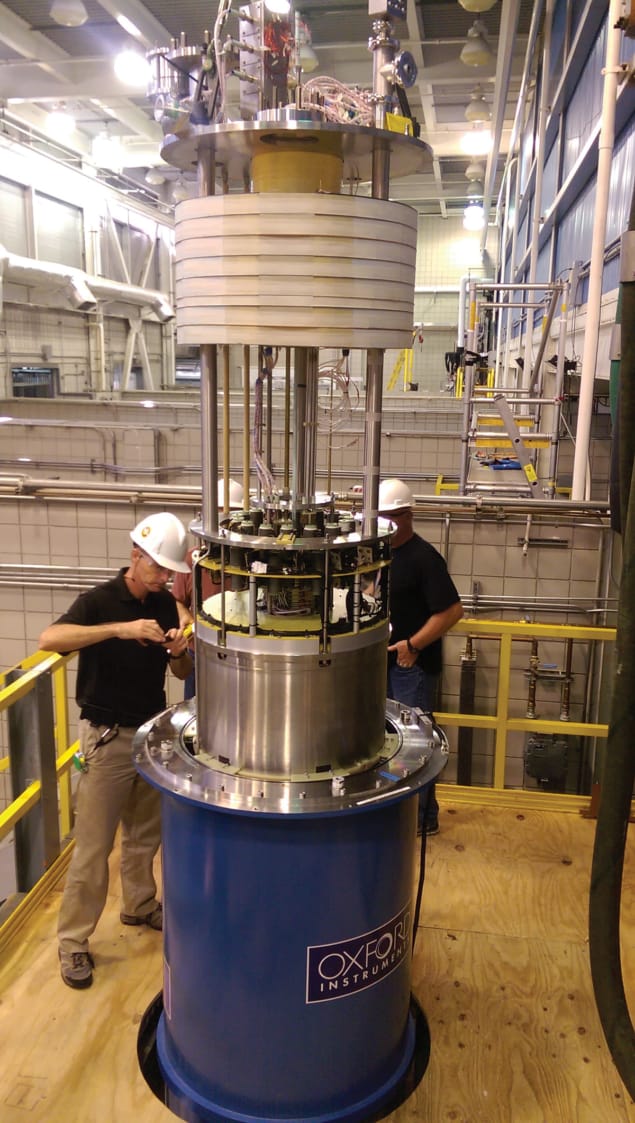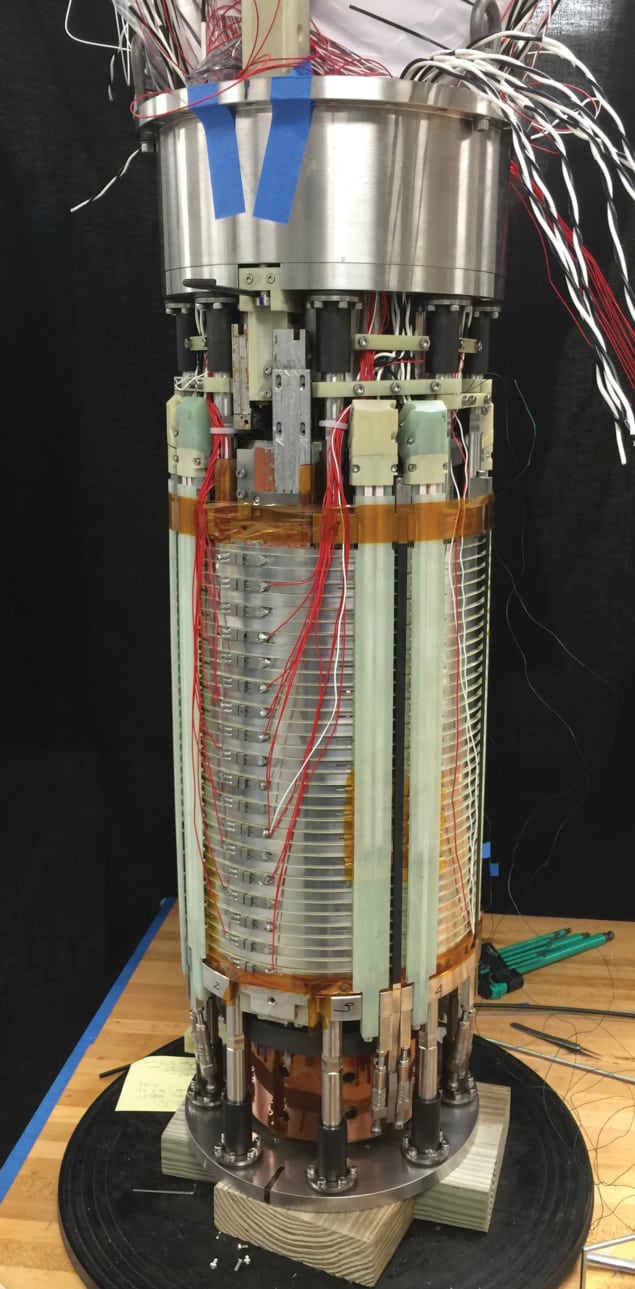Super-strong magnets are a relatively recent phenomenon. Before the 19th century, the only magnets available were naturally occurring rocks made from a mineral called magnetite. This began to change after 1819, when the Danish scientist Hans Christian Ørsted discovered that electric currents in metallic wires create magnetic fields, but the real leap in magnet strength did not come until nearly a century later, with the discovery of superconductivity. Superconductors conduct electricity with perfect efficiency, which is a huge advantage for making strong magnets: today’s most powerful commercially available superconducting magnets can produce a stable field of up to 23 T, which is more than 2000 times stronger than the magnet on your fridge.
In December 2017 improvements in low-temperature-superconductor (LTS) magnet technology, together with advances in high-temperature superconducting (HTS) materials, produced another change in magnet development. The successful demonstration of a 32 T all-superconducting magnet by the National High Magnetic Field Laboratory (NHMFL) in Florida, US, was a significant milestone in the field. The new super-magnet is expected to become available to users in 2019, and its high, stable field will help scientists break new ground in studies of nuclear magnetic resonance, electron magnetic resonance, molecular solids and quantum oscillation studies of complex metals, among other areas. In the longer term, the wider availability of such strong magnetic fields is also expected to enhance our understanding of superconductors and nanomaterials, leading to new nano-devices and applications.
There are, however, several challenges associated with designing and manufacturing magnets capable of producing fields of > 25 T. The amount of stored energy in systems like these is huge, and managing the electromagnetic forces and stresses associated both with energizing the magnet, and with allowing it to warm up and “quench” (as the transition from superconducting to resistive behaviour is known), is no easy task. Producing high-quality, uniform LTS and HTS wires and tapes by the metre (and indeed by the kilometre) is also difficult. The success of the 32 T final design did not happen overnight; rather, it was the product of intense engineering and materials development over nearly a decade.
Finding the right superconductor
A superconducting magnet of ≥25 T typically comprises an outer magnet (or “outsert”) made from LTS materials and an insert that uses HTS materials. In the 32 T NHMFL magnet, the outsert section consists of three coils of niobium-tin (Nb3Sn) and two coils of niobium-titanium (NbTi), all supplied by Bruker-Oxford Superconducting Technology. Together, these coils deliver a field of 15 T via a 250 mm wide-bore magnet. The insert section delivers 17 T in a 34 mm cold bore developed by NHMFL using advanced HTS superconducting tapes manufactured by Superpower Inc. The two sections were integrated by a team of scientists at the NHMFL, supported by a team at my company, Oxford Instruments Nanoscience, which also developed the magnet’s outsert and its cryogenic system.
The dual-component design of high-field magnets is necessary because LTS-only magnets cannot produce a field much beyond 21 T at 4.2 K (or 23 T at 2.2 K) due to the physical limitations of LTS materials. For example, NbTi was developed in the 1970s and has been the “workhorse” of superconducting magnets ever since. However, NbTi material can only function as a superconductor at fields of up to 10 T at 4.2 K (and not more than 11.7 T at 2.2 K) for magnets with narrow bores of less than 60 mm. For larger-bore magnets, the maximum field is even lower, limiting the material’s usefulness in high-field magnets. Coils made from Nb3Sn material can remain superconducting at up to 23 T at 2.2 K, much higher than is possible for NbTi, but they also need to have a very fine filament-like structure to prevent a phenomenon known as flux jumping that dissipates energy in the superconductor and can cause the coil to quench prematurely. Hence, the manufacture of Nb3Sn wire has to be done with stringent quality-control procedures in place to ensure that it will perform stably at high fields.
HTS materials, in contrast, can carry significant current at 4.2 K, and they remain superconducting far above the magnetic field limits inherent to niobium-based wires, having shown good performance in fields of up to 45 T (which can be generated by magnets that incorporate resistive as well as superconducting coils). However, these materials come with additional challenges in terms of their cost, reliability and acceptance within the user community. The first generation of HTS wire was made from a cuprate-based superconductor, bismuth strontium calcium copper oxide (Bi-2212). This material performs consistently regardless of magnetic field orientation, but manufacturing it requires the material to undergo a very precise heat treatment in oxygen, after which it becomes extremely brittle and therefore highly strain sensitive. The NHMFL 32 T magnet uses a second-generation HTS wire made from YBCO, a superconducting ceramic composed of yttrium, barium, copper and oxygen. Production of YBCO wires and tapes has increased during the last few years, and their mechanical properties are better than for Bi-2212, but they display anisotropic effects with respect to field orientation that need to be accounted for in magnet design. They also require more sophisticated quench-management systems. In short, both materials have their challenges, but also some advantages, and are strong candidates for high-field magnets.
Managing stored energy and stress
For the superconductors in the magnet’s insert and outsert to operate, both components must be kept fully immersed in a bath of liquid helium at 4.2 K. A scant few μJ of additional energy – equivalent to the potential energy of a pin dropped from the height of just a few centimetres – would be enough to raise the temperature above the point where the coils become resistive, and the magnet undergoes a quench. When that happens, the helium boils off and all the energy stored in the magnet is released very quickly, risking damage to its structure if the quench process is not properly managed. The potential for damage is significant, too: at the maximum field of 32 T, the energy stored in the NHMFL magnet is more than 8.3 MJ, approximately equal to the energy in 2 kg of TNT.
High-field magnets already play an important role in enabling scientific research and development
How can you manage the dissipation of 8.3 MJ of energy in a way that won’t cause terminal damage either to the magnet or to objects around it? The solution is a quench-management system that releases the energy very quickly, but in a way that avoids magnet damage through thermal gradients or excessive voltages in the coil. This system (a dedicated and patented solution developed by Oxford Instruments) ensures that, during failure mode, all of the stresses on the coils and their voltages are kept within design limits to ensure no excessive challenge to material performance. For example, specially designed coil heaters are used to make the magnet coils resistive, which disperses the energy from the quench evenly and safely, and prevents sections of the coil being damaged by localized excessive voltages. In addition, the safety of the integrated magnet system is maintained by sensors that monitor small variations in temperature, voltage, current or the physical position of wires and tapes. Some of this information is then fed into a central processor, which determines whether a “real” quench event is occurring and, if necessary, discharges the stored energy in a timely and safe manner.
In addition to storing large amounts of energy, high-field magnets also experience huge degrees of electromagnetic stress. For a given magnet, the quantity of mechanical stress increases quadratically with the field strength, and at 32 T these stresses add up to more than 300 tonnes, with a magnetic pressure of more than 250 MPa. Traditional ways of reinforcing magnetic coils involve impregnating them with wax to create a self-supporting structure that prevents the Lorentz force on the coil from damaging them during operation, or mechanical movement leading to repeated coil quench. However, at very high fields this is not enough. Instead, the coils for the LTS outsert were evacuated in a special vacuum chamber, and the chamber was then brought back up to atmospheric pressure after epoxy resin had been introduced to replace the air voids within the coils. This process makes it possible for the coils to withstand forces exceeding 300 tonnes.
Prospects for discoveries
High-field magnets already play an important role in enabling scientific research and development. Many significant discoveries, including several that were subsequently honoured with Nobel prizes in physics, chemistry or medicine, have been made with the help of strong magnetic fields. High-field superconducting magnets are also an essential technology for particle accelerators and colliders, and they play a critical role in fusion devices such as the International Thermonuclear Experimental Reactor (ITER).
In my view, though, some of the most exciting future applications for devices like the 32 T NHMFL magnet can be found in the field of nanotechnology. High-field magnets will enable the study and manipulation of atoms and molecular structures in the range 1–100 nm, helping us to understand how the properties of materials at this scale can be improved to achieve greater strength, enhanced reactivity, better catalytic function and higher conductivity. In combination with low temperatures, high fields are also a crucial aid in studying, modifying and controlling new states of matter. Superconducting magnets provide these high magnetic fields without the enormous power consumption and large infrastructure requirements of resistive magnets. The new, even more compact 32 T magnet will reduce the associated running costs still further, making high-field research accessible to a broader range of scientists and institutions.



No comments:
Post a Comment